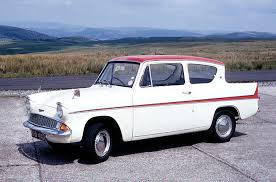-
Insurance
InsuranceAbout our productsLearn about insuringGet a quote Get current values, historical values, model history and more.
-
Valuation
ValuationHagerty valuation toolLook up a vehicle value Get current values, historical values, model history and more.
-
Events
EventsHagerty official eventsHagerty ClubhouseEvent calendar
-
Entertainment
EntertainmentMore to explore
- Portal login
1947 Ford Anglia
E04A 2dr Saloon 0.9 L
Vehicle values by condition
Fair
Condition 4
£2,900
#4 cars are daily drivers, with flaws visible to the naked eye. The chrome might have pitting or scratches, the windshield might be chipped.
Good
Condition 3
£5,300
#3 cars could possess some, but not all of the issues of a #4 car, but they will be balanced by other factors such as a fresh paint job or a new, correct interior.
Excellent
Condition 2
£7,100
#2 cars could win a local or regional show. They can be former #1 cars that have been driven or have aged. Seasoned observers will have to look closely for flaws.
Concours
Condition 1
£8,000
#1 vehicles are the best in the world. The visual image is of the best car, unmodified, in the right colours, driving onto the lawn at the finest concours.
Insurance premium for a
1947 Ford Anglia E04A 2dr Saloon 933
valued at £5,300
£98.55
/ year*
History of the 1945 - 1948 Ford Anglia

1945 - 1948 Ford Anglia
Ford started making right-hand-drive cars in England in 1911. First came American Model Ts, then Model As from 1927 until 1932. There was also a smaller-engine 14.9-horsepower Model A to circumvent British road taxes.
Ford introduced the 8-horsepower 933cc Model Y in 1932, built at the new Dagenham factory, with a new side-valve engine. This European Ford resembled the full-size American two-and four-door saloon, with a shield-shaped radiator and a curved back that lacked a boot.
The 10-horsepower 1172cc, Model C followed in 1935 with a rounder body and a boot. It was redesigned in 1938 with semi-stressed bodywork and an alligator bonnet and the four-door was named the Ford Prefect. A redesigned two-door was introduced as the Ford Anglia for 1939.
A side-curtained Anglia tourer was available before the war, but did not return to the UK market afterwards. It continued to be sold in British overseas markets like Australia, Canada and South Africa. Australia also offered a saloon-based 'Ute' pickup, and a commercial van was available worldwide throughout the run. However, the spare wheel was hung on the driver’s door, which must have been hard on the hinges.
The 'sit-up-and-beg' E93A Anglia was unchanged for 1945, still with a 3-speed gearbox, mechanical brakes, rigid axles, transverse-leaf springs, a single windscreen wiper and no heater. The sole instrument was a large speedometer which also housed a petrol gauge and generator light. The larger 1172cc engine was available for export, but you could only buy such a car with dollars. In 1948, the vertical radiator shell was replaced by a BMW-style sloping kidney grille.
While these cars are incredibly basic, they are surprisingly durable, and the 933cc engine can manage 40 mpg. Acceleration is best described as leisurely and top speed is about 55 mph, which is plenty considering the mechanical brakes. The transverse springs transmit the impact of cats-eye road reflectors violently enough to shake down the side windows. Turn signals were not offered, but many cars had semaphores or flashers fitted later, though the 6-volt system makes flashers exceedingly slow at idle. The single vacuum wiper crawls when climbing hills, or running over 35mph, then slaps itself silly on deceleration.
Aftermarket heaters may be found, but since the radiator operates solely on convection, a water pump had to be installed to direct hot water into the car. The ingenious installation involved running the water pump pulley on the back of the fan belt.
The Ford Anglia was the first new car that many Britons bought, and 166,864 were sold between 1939-53, when it was replaced by a full-width monocoque Anglia. The 'shoebox' Anglia 100E had McPherson strut front suspension and hydraulic brakes, but still used the same old 1172cc side-valve engine and 3-speed gearbox. The final Anglias were renamed Popular in 1953 and built without change until 1959, still with their 1930s specifications. At £391 they were the cheapest full-size car available to British buyers. Survivors are quite numerous and spares quite plentiful. Colors were limited throughout the model’s run; most were black, although grey, tan, light blue or light green can be found in later years.
Hagerty Newsletter
Get your weekly dose of car news from Hagerty UK in your inbox

ADVERTISEMENT